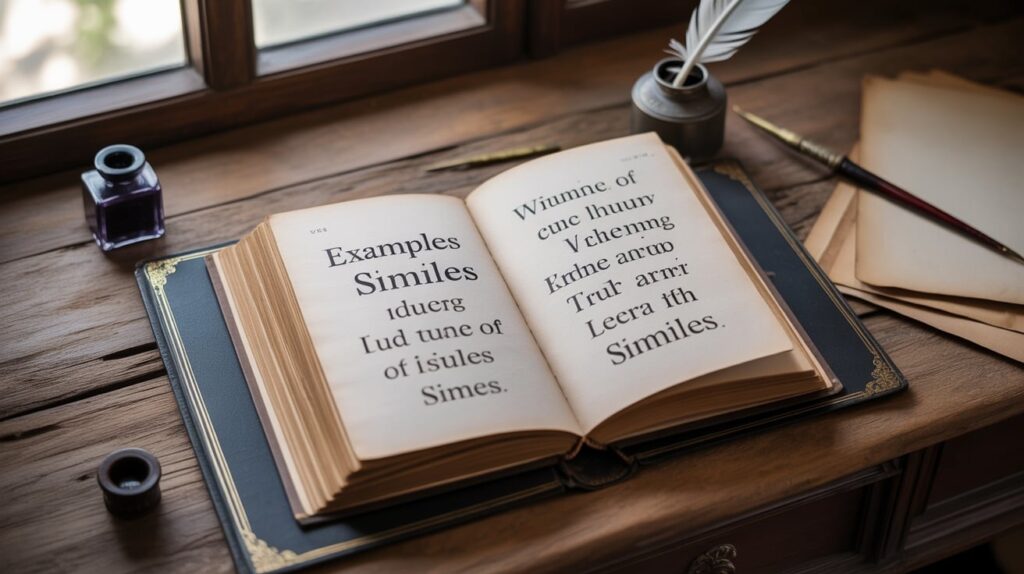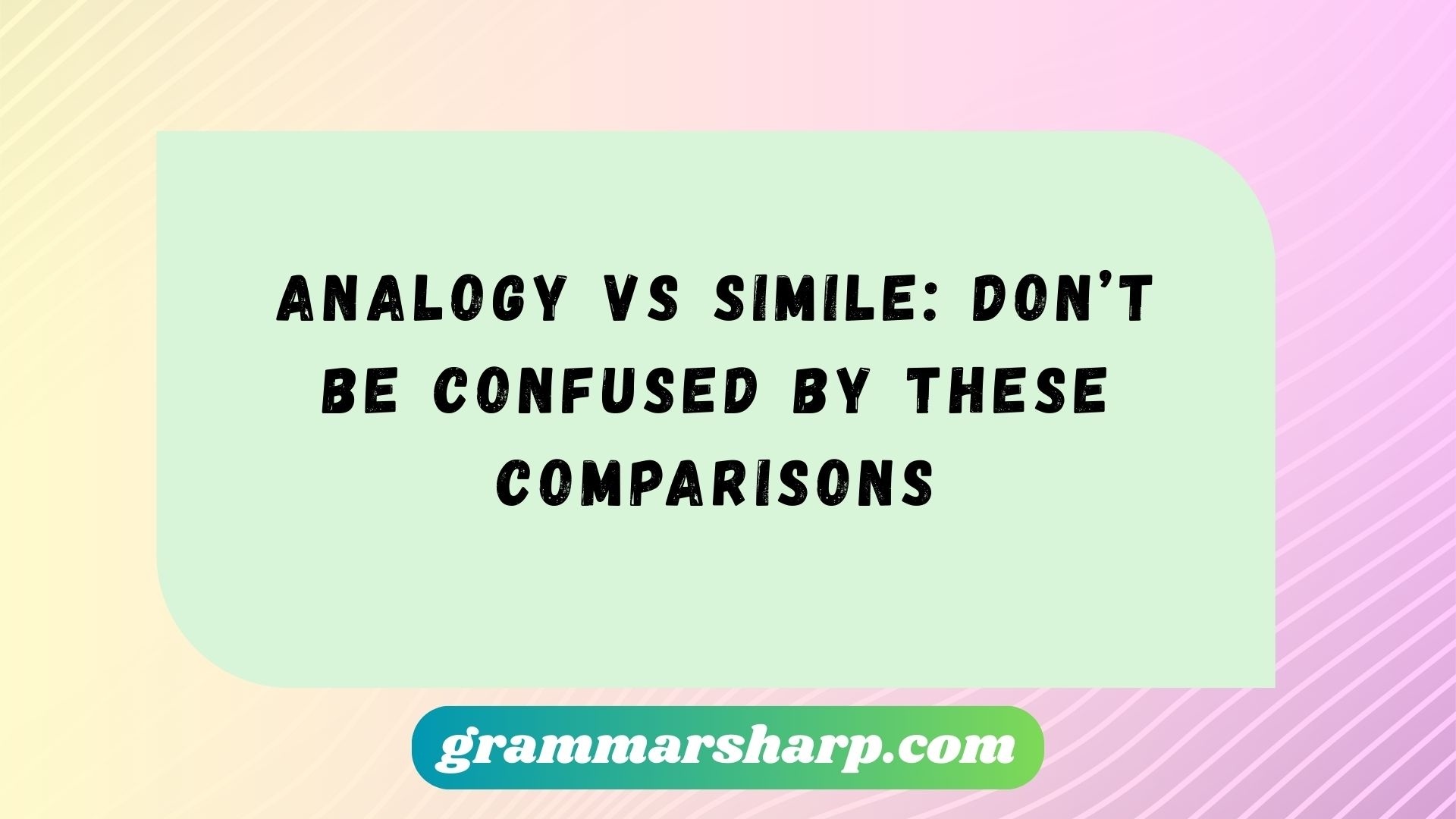Language thrives on comparisons. They help us explain complex ideas, paint vivid pictures, and spark imagination. When you describe someone as “busy as a bee” or say “life is like a box of chocolates,” you’re leaning on comparisons to make your point stronger. But here’s where things often get confusing: is that a simile or an analogy?
People mix them up all the time, and it’s easy to see why. Both compare two things. Both are used in writing and everyday speech. Both can make your words more engaging and memorable. However, they’re not identical. Understanding the difference between analogy vs simile can sharpen your communication skills, whether you’re writing an essay, telling a story, or giving a speech.
This guide clears up the confusion. You’ll discover:
- What a simile actually is, in simple terms
- How an analogy works (and why it goes deeper than a simile)
- Clear examples of both, from literature to pop culture
- Common misconceptions that trip people up
- Practical tips for using similes and analogies effectively
By the end, you’ll not only know the difference between similes and analogies, but you’ll also be able to use them like a pro in your own conversations and writing. Let’s dive in.
What Is a Simile?
A simile is a figure of speech that compares two different things using the words “like” or “as.” It’s often short, catchy, and easy to recognize.
Think of it as a quick comparison tool. A simile doesn’t need to explain the relationship in detail. Its main job is to make a description more vivid and relatable.
Examples of similes:
- Her smile was as bright as the sun.
- He ran like a cheetah chasing prey.
- The classroom was as silent as a graveyard.
Why Writers Use Similes
- Imagery: They create mental pictures.
- Relatability: They connect abstract ideas to familiar experiences.
- Emotional impact: They can evoke feelings quickly.
For example, saying “He’s strong as an ox” is far more powerful than just saying “He’s strong.” The simile paints a clearer, stronger picture in the reader’s mind.
What Is an Analogy?
An analogy also compares two things, but it goes further than a simile. Instead of a quick resemblance, an analogy explains the relationship between two things to clarify an idea.
Think of an analogy as a teaching tool. It takes something unfamiliar and makes it easier to understand by comparing it to something more familiar.
Examples of analogies:
- “Life is like a box of chocolates — you never know what you’re going to get.” (From Forrest Gump)
- “The human brain is like a computer. It stores information, retrieves data, and processes inputs.”
- “Finding a good friend is like finding a needle in a haystack.”
Why Writers and Speakers Use Analogies
- Clarification: They explain complex concepts in simple terms.
- Persuasion: They make arguments more convincing.
- Connection: They help audiences relate to unfamiliar ideas.
For example, teachers often use analogies in classrooms: “Electric current flows like water through pipes.” This helps students visualize something abstract
Analogy vs Simile — The Key Differences
At first glance, a simile and an analogy might look alike. Both use comparisons. Both can include “like” or “as.” But the difference lies in depth.
Here’s a quick comparison table to make it clearer:
| Feature | Simile | Analogy |
| Definition | A direct comparison using “like” or “as” | A deeper comparison explaining a relationship between two things |
| Purpose | Create vivid imagery | Explain or clarify an idea |
| Length | Usually short | Often longer and detailed |
| Example | “She’s as graceful as a swan.” | “A CEO is like the captain of a ship: steering, guiding, and making decisions.” |
👉 In short: A simile says two things are alike, while an analogy explains how they’re alike and why it matters
Examples of Similes

Here are some similes you’ve likely heard in everyday life:
- He’s as brave as a lion.
- The water was cold as ice.
- She sings like an angel.
- The room was as busy as a marketplace.
- His hands were as rough as sandpaper.
Similes in Literature and Pop Culture
- Shakespeare wrote: “My love is like a red, red rose.”
- Taylor Swift sings: “You call me up again just to break me like a promise.”
- Movies often use similes in dialogue to make lines memorable.
Similes shine in creative writing, helping authors draw readers into a scene with striking imagery.
Examples of Analogies
Analogies are everywhere — in classrooms, speeches, literature, and even advertising.
Everyday analogies:
- “Finding a parking spot in the city is like finding gold.”
- “Just as a seed needs water to grow, your mind needs knowledge to flourish.”
Scientific analogies
- “Electricity flows like water in a pipe.”
- “DNA is like a blueprint for building a body.”
Literary analogies:
- In George Orwell’s Animal Farm, the farm itself is an analogy for political systems.
- Martin Luther King Jr. used analogies in speeches: “Injustice anywhere is a threat to justice everywhere.”
Analogies often carry teaching power. They don’t just describe; they explain.
Common Misconceptions About Analogy and Simile
Many people assume:
- “All similes are analogies.” This isn’t accurate. While some similes can function within analogies, not every simile explains a relationship deeply enough to qualify.
- “Analogies always use like or as.” Not true. Many analogies explain relationships without those words.
👉 Example:
- Simile: “He’s as tall as a giraffe.”
- Analogy: “Just as a giraffe can see far across the savannah, he can see opportunities others miss.”
The analogy expands beyond resemblance to explain why the comparison matters.
Why Writers Use Similes and Analogies
Both similes and analogies enhance communication — but in different ways.
Benefits of Similes
- Add beauty and imagery to writing
- Create memorable expressions
- Connect emotions to familiar images
Benefits of Analogies
- Simplify complex concepts
- Strengthen arguments and persuasion
- Build stronger connections with the audience
In short, similes decorate, analogies educate.
Analogy vs Simile in Literature and Everyday Speech
In Literature:
- Shakespeare, Milton, and other great writers leaned heavily on similes to enrich imagery.
- Philosophers and essayists often favored analogies to clarify ideas.
In Everyday Speech
- Similes: “She’s sharp as a tack,” “It’s hot as an oven.”
- Analogies: “Friendship is like a plant — it needs care to grow.”
Both forms appear naturally because humans love comparing the unfamiliar with the familiar.
Tips for Using Similes and Analogies Effectively
- Keep them clear: Avoid confusing or far-fetched comparisons.
- Know your audience: Use analogies and similes that your readers can relate to.
- Don’t overuse them: Too many comparisons weaken the impact.
- Choose fresh images: Avoid clichés when possible.
Example of poor use:
- “He was like a cloud of uncertainty floating in a world of indecision.” (Too vague)
Better use:
- “He was like a locked door — hard to reach, harder to open.” (Clear, vivid)
Conclusion
Language thrives on comparisons because they make our words sharper and more relatable. The confusion between analogy vs simile happens because both involve comparing two things. However, the difference is simple: a simile creates imagery while an analogy explains relationships.
Writers, speakers, and even teachers rely on these tools because they make ideas stick. The next time you come across a clever comparison, ask yourself: Is it painting a picture, or is it teaching me something? That’s how you’ll know if it’s a simile or an analogy.
FAQs
What’s the difference between an analogy and a simile?
A simile compares two things directly using “like” or “as.” An analogy explains the relationship between them, often in more detail.
Is every simile an analogy?
No. Some similes are part of analogies, but not all qualify as analogies because they don’t always explain relationships.
How is an analogy different from a metaphor?
A metaphor states one thing is another, while an analogy explains how two things are similar in function or relationship.
Can analogies be funny?
Yes. Comedians often use humorous analogies: “Marriage is like a deck of cards: at the start, all you need are two hearts and a diamond. By the end, you’re looking for a club and a spade.”
Why do teachers love analogies?
Analogies simplify complex concepts, making it easier for students to connect abstract ideas to real-world experiences.
Which is stronger in writing: simile or analogy
Neither is “better.” Similes excel at imagery, while analogies excel at explanation. The best writers use both strategically.

